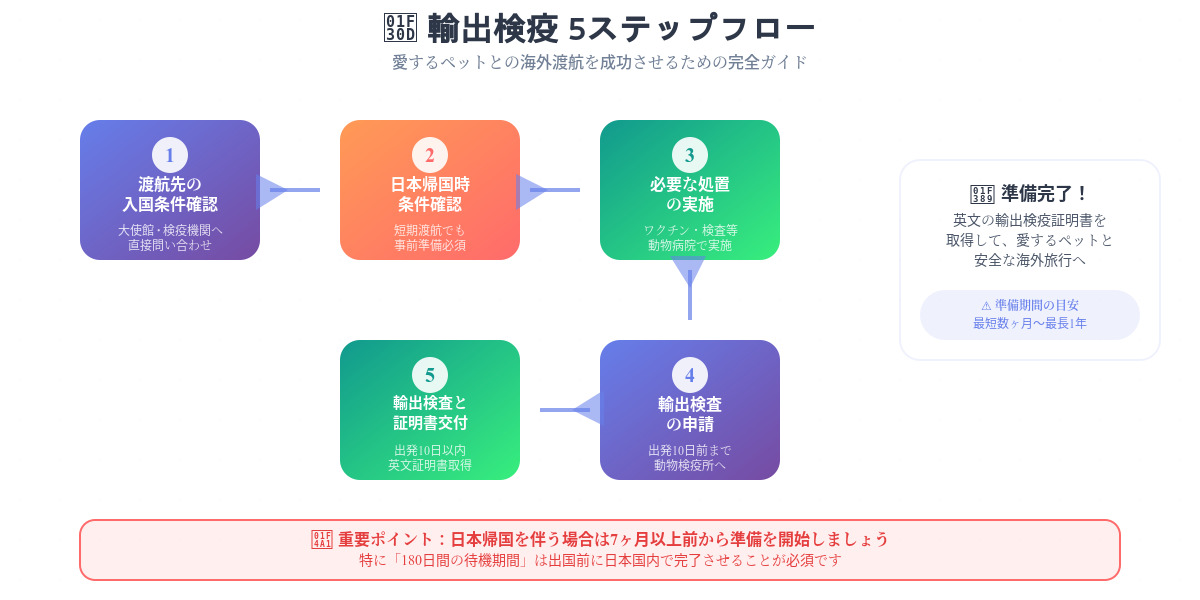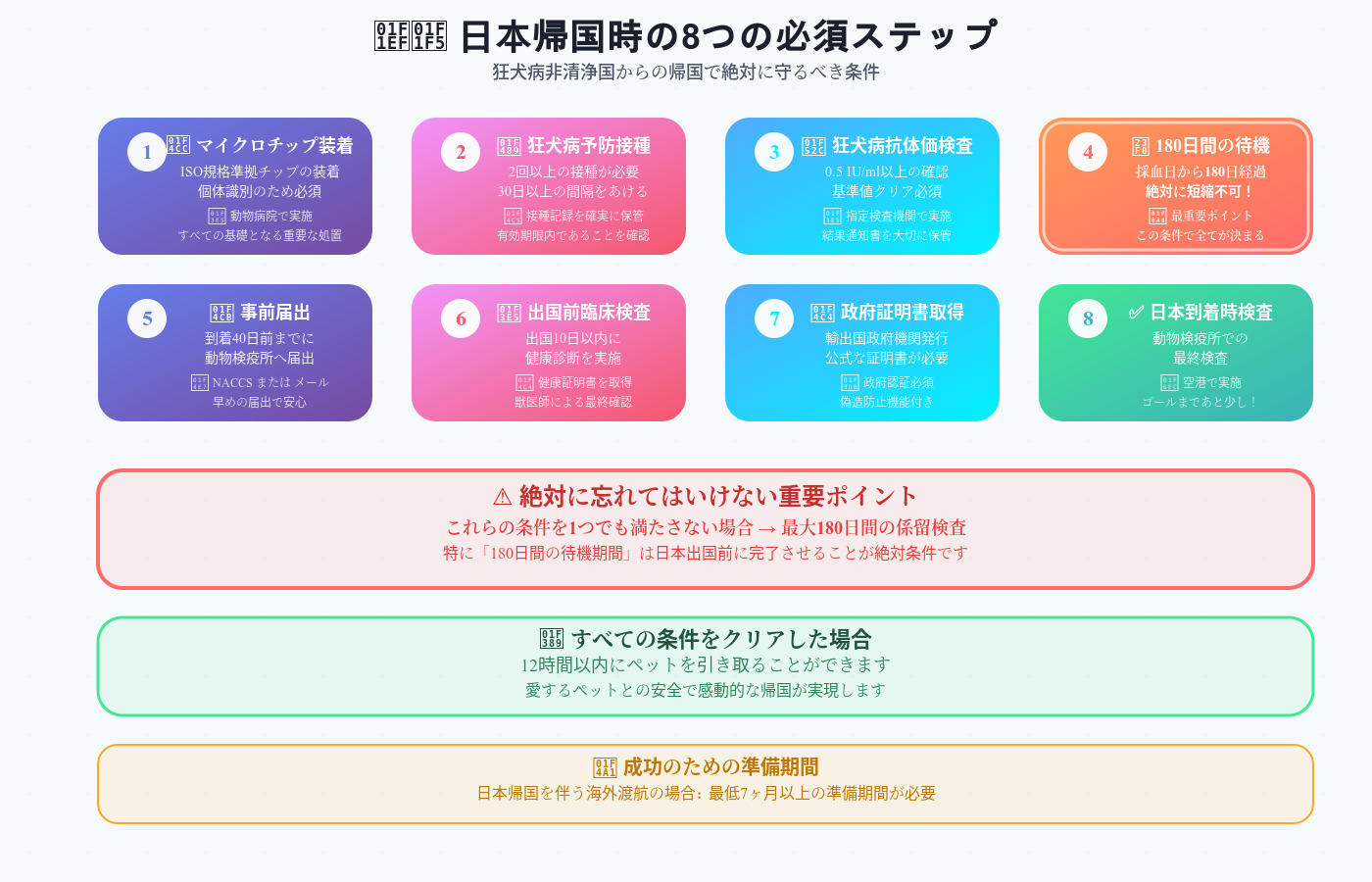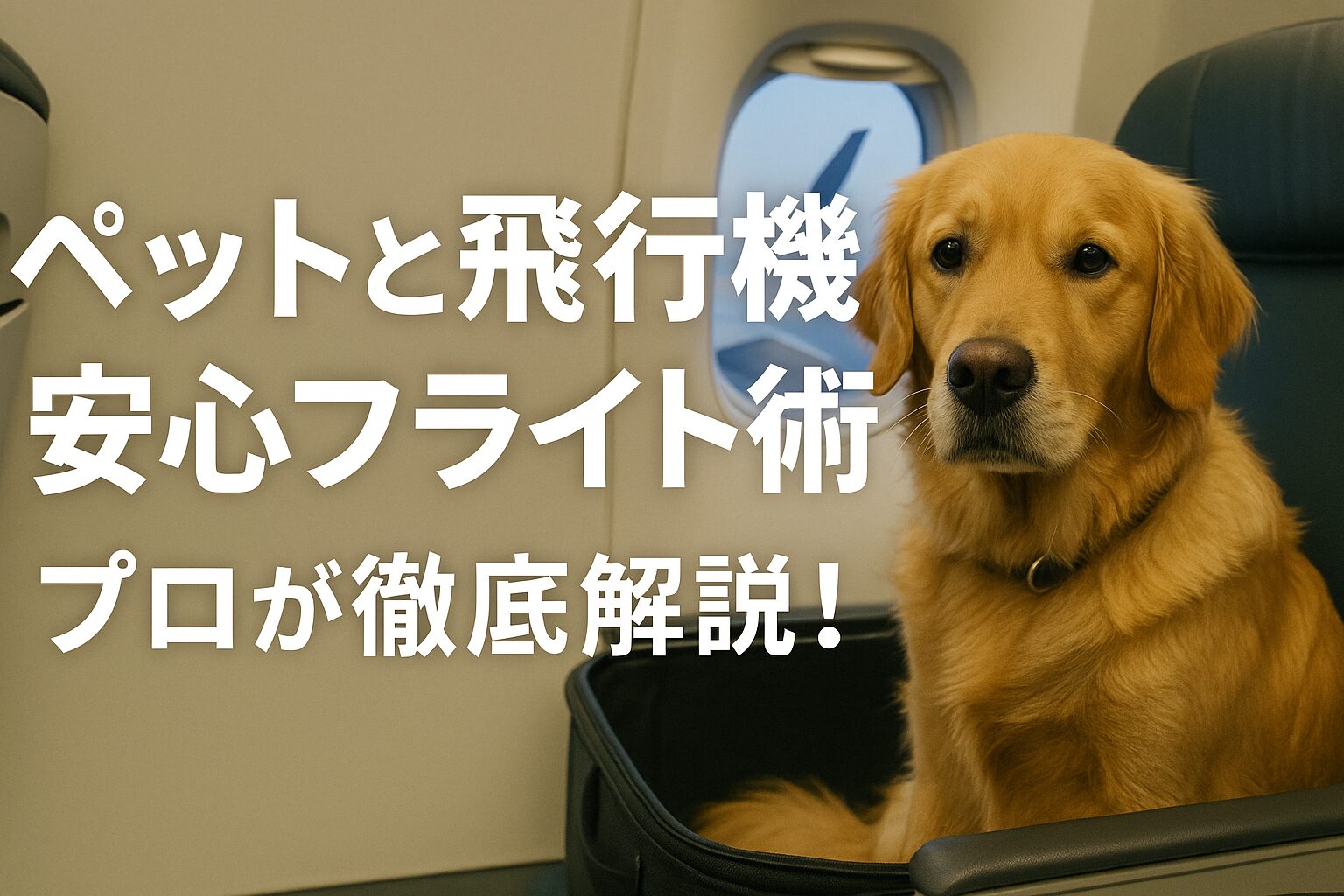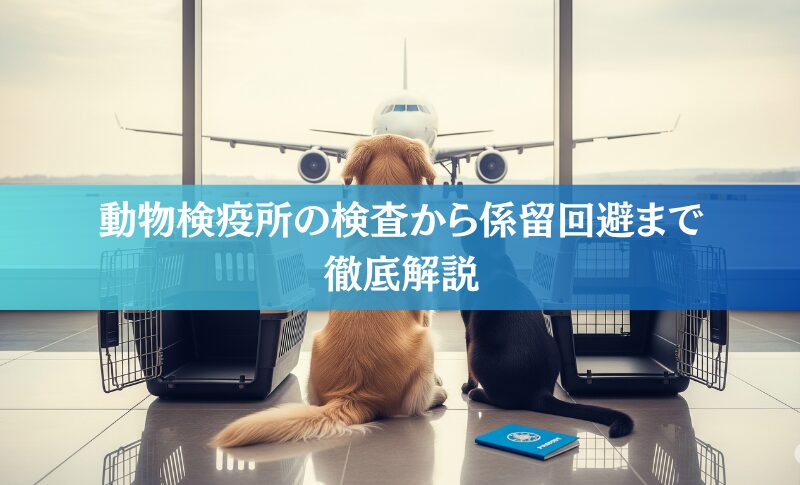For those who plan to travel abroad with their dog or cat, animal quarantine procedures are an important process that cannot be avoided.
Japan.rabies-free countryThe country is recognized worldwide as a "world leader in animal welfare" and protects the health and safety of animals through a strict quarantine system.
However, this quarantine procedure is more complicated than one might imagine, and preparationMinimum several months, in some cases nearly a year.may be required. Because failure to follow procedures can, in the worst case scenario, lead to separation from a beloved pet and a lengthy mooring inspection,Accurate knowledge and systematic preparationis essential.
📝 Key points of this article
Based on the latest information from the Animal Quarantine Service of the Ministry of Agriculture, Forestry and Fisheries, this guide provides a comprehensive overview of animal quarantine procedures for dogs and cats traveling overseas.
✅ Complete Guide to Pre-Export Inspections
⭐ Special Requirements by Destination and Notes on Returning to Japan
🎯 Preparation period and specific timeline strategies
💡 Frequently asked questions and measures
💬 If you need help with procedures, you can download sales materials and consult with experts on our official line
🏛️ Basics of Japan's Animal Quarantine System
📋 Legal basis and purpose
Japan's animal quarantine system is,Rabies Prevention Law and Livestock Infectious Disease Prevention LawThe program operates under two important laws. The main purpose of these laws is to prevent the international spread of infectious diseases through the import and export of animals.
Rabies is explained in detail in the following article.
💡 System Features
The Animal Quarantine Service (AQS) of the Ministry of Agriculture, Forestry and Fisheries (MAFF) has jurisdiction over quarantine operations and has established branch offices at major airports and ports throughout Japan to conduct quarantine operations 24 hours a day. If you fail to follow the procedures,Possible legal penaltiesThe proper procedures must always be followed because there are also
🐕 Target Animals and Test Contents
Animal quarantine covers a wide range of animals, including dogs and cats, cattle, pigs, horses, domestic animals, and rabbits.Dogs and CatsThe explanation will focus on
In quarantine, the following infectious diseases are tested for
🐕 In dogs: rabies, leptospirosis
🐱 For cats: rabies
These tests are an important process to confirm the health status of your pet and to check for infectious diseases.
✈️ Complete Guide to Pre-Export Inspections Abroad
🔄 Basic Flow of Export Quarantine
Animal quarantine for dogs and cats taken from Japan to overseas is5 StepsIt is composed of

STEP 1: Check the entry requirements for your destination country
The most important and first thing to do is,Direct inquiries to the animal quarantine agency of the destination country or embassy in JapanIt is. Failure to confirm this may seriously impede later procedures, as requirements vary widely from country to country.
Key items to check:
✅ Requirement of microchipping
✅ Frequency and timing of rabies vaccinations
✅ Need for antibody titer testing
✅ Import Permit Required
✅ Requirements for parasite control
✅ Health Certificate Format
The following article explains microchipping in detail.
💡 STEP 2: Confirm conditions upon return to Japan
Short-term travel with the possibility of returning to Japan in the future,Check and prepare for return conditions at the same time before leaving the countryIt is important to do so. Preparation is essential, especially since there are strict requirements for returning from rabies-free countries.
📋 STEP 3: Perform necessary procedures
Based on the conditions of the destination country, the following procedures are performed at the veterinary hospital:
🔹 ISO standard microchip installation
🔹 Rabies vaccination (number of times required)
🔹 Other vaccinations
🔹 Rabies antibody titer test (if necessary)
🔹 Parasiticidal treatment
💡 STEP 4: Apply for export inspection
To the animal quarantine station with jurisdiction over the airport or port of departure,Up to 10 days prior to the desired inspection dateThe application will be submitted to NACCS. Applications can be made via NACCS (National Animal Quarantine Control and Control System) or by e-mail.
STEP 5: Export Inspection and Issuance of Certificate
If the pet itself is inspected at the animal quarantine station within 10 days of departure and passesExport quarantine certificate in EnglishThis certificate is an important document that is required for immigration procedures in the destination country. This certificate is an important document that is required for immigration procedures in the destination country.
📄 Required Documents and Preparation
The main documents required for export quarantine are as follows
📋 Preliminary Preparation Documents
📌 Certificate of microchip installation
💉 Rabies vaccination certificate
🩺 Other vaccination certificates
🔬 Notification of rabies antibody titer test results (if required)
🐛 Certificate of parasite extermination
🏥 Health Certificate (if required)
📄 Documents issued by the animal quarantine office
📜 Export quarantine certificate (English)
📋 A copy of the application for export inspection
🌏 Destination Requested Documents
📃 Import Permit (Import Permit)
🏥 Specific form of health certificate
⏰ Time and cost of inspection
💡 Estimated inspection time and cost
⏱️ Inspection time (typical): 30 minutes to 1 hour
💰 Quarantine fee: Free
📝 *Varies depending on the number of heads and conditions.
Out-of-pocket expenses:
💊 Cost of various veterinary procedures
💉 Vaccine and testing costs
📄 Certificate issuance fee
🧳 Transportation cage costs
✈️ Airfare (pet transportation fee)
🌏 Special requirements and notes by destination
🏆 Travel to rabies-free countries
Major target countries:England, Australia, New Zealand, Hawaii
These countries are similar to Japan.rabies-free countryTherefore, an extremely strict quarantine system is in place.
🇦🇺 For Australia
⚠️ Strict requirements
📋 Import Permit must be obtained in advance
📅 Identification of individuals at the animal quarantine station 6 months prior to travel
🔬 Multiple disease testing (leptospirosis, brucellosis, etc.)
🏥 Mooring inspection at a government designated facility for a minimum of 10 days after arrival
🇬🇧 United Kingdom (EU compliant)
📌 Rabies vaccination after microchipping
🐛 Stripworming of dogs to prevent echinococcosis (within 120-24 hours prior to travel)
📄 Animal Health Certificate in the form specified by the EU
⚠️ Travel to rabies-free countries
Major target countries:U.S.A., Canada, Thailand, Singapore
🇺🇸 For the U.S.
⚠️ New rules from August 2024
CDC (Centers for Disease Control and Prevention) regulations have been strengthened:
📌 Obligation to microchip dogs over 6 months of age
💉 Rabies vaccination certificate
📋 CDC dog importation form pre-submission (if applicable)
🌏 Southeast Asian countries
🇹🇭 Thailand and Vietnam: relatively moderate conditions
🇲🇾 Malaysia and Singapore: prior import permit and mooring inspection required
Malaysia and Singapore are explained in detail in the following articles.
▶︎Complete Guide to Malaysia Import Procedures for Dogs and Cats|Regulations, Costs, Preparation, and Local Procedures
▶︎Moving to Singapore with your dog or cat! A Complete Guide from Procedures to Finding a Place to Live
🔄 Precautions for short-term travel (with return to Japan)
⚠️ Important rules for short-term travel and "180-day wait"
Short-term travel to a rabies-free country with plans to return to Japan,Complete all preparations for returning home in Japan prior to departure.It is necessary. There are many misconceptions, especially regarding the "180-day waiting period".
Important: The waiting period is not waived!
The whole "it's a short trip, so you're exempt from the waiting list" thing.errorThe correct answer is "yes". To be correct, pets can return to Japan unmoored after the following preparations have been completed prior to departure from Japan and 180 days have elapsed from the date of blood collection for the antibody titer test.
Preparation required:
📌 Microchip installed
💉 Rabies vaccination (at least 2 times)
🔬 Rabies antibody titer test (confirm antibody titer above standard value)
⏰ Wait 180 days from the date of blood collection for antibody titer testing (to be completed in Japan)
Completing this preparation and returning home within the validity period of the antibody titer (2 years) will ensure a smooth entry into Japan. If you return home before the end of the waiting period, you will spend the remaining days in quarantine facilities at the airport, so systematic preparation is essential.
🇯🇵 Import quarantine procedures for Japan
🗺️ Classification of designated and non-designated areas
Japan's import quarantine system divides countries and regions of origin into the following two categories
📍 Differences by regional classification
🏆 Designated areas (rabies cleanup areas)
Iceland, Australia, New Zealand, Fiji, Hawaii, Guam, United Kingdom
⚠️ Outside of designated areas (rabies-free areas)
All countries/regions other than the above
The required procedures and preparation time differ greatly depending on this classification.
Hawaii and Guam are described in detail in the following articles.
▶︎A complete guide to traveling to Guam with your dog|Thorough explanations of everything from procedures to sightseeing!
▶︎A complete guide to traveling with your dog to Hawaii!
🏆 Import procedures from designated areas
📅 Residency History Requirements
One of the following must be met
🌎 Bred within the designated area since birth
📅 Stay in designated area for more than 180 days immediately prior to export
🇯🇵 Stay only in designated areas after leaving Japan
📋 Key Procedures
1️⃣ Advance notification (up to 40 days prior to arrival)
2️⃣ Pre-departure clinical examination (within 10 days)
3️⃣ Obtaining certificates issued by government agencies
4️⃣ Import inspection upon arrival in Japan
Preferential treatment
If you meet the requirements.No rabies vaccination or antibody titer test requiredand can be picked up within 12 hours of arrival.
⚠️ Procedures for importing from outside designated areas

📋 8 essential steps
1️⃣ Microchip installed:Mounting of ISO standard compliant chips
2️⃣ Rabies vaccination:Two or more vaccinations (at least 30 days apart)
3️⃣ Rabies antibody titer test:Confirmation of antibody titer of 0.5 IU/ml or higher
4️⃣ 180-day waiting period:180 days after the date of antibody test blood collection
5️⃣ Prior notification:Notification up to 40 days prior to arrival
6️⃣ Pre-departure clinical examination:Medical examination within 10 days of departure
7️⃣ Obtained government certification:Certificate issued by the government agency of the exporting country
8️⃣ Inspection upon arrival in Japan:Import inspection at animal quarantine station
⚠️ Important Note
If any one of these conditions is not met,Mooring inspection for up to 180 daysis required.
🏥 Mooring Inspection
🚫 Main cases where mooring is required
❌ 180-day waiting period shortfall
❌ Rabies antibody titer below threshold
❌ Failure to provide required documentation
❌ Failure to submit prior notification
⚠️ Expenses during mooring period
Inspection fee:free
Feeding and management fees:full payment on one's own account
Transportation costs:paying one's own expenses
⏰ Preparation period and timeline strategy
📅 Approximate preparation time by destination
💡 Approximate preparation time
⚡ Several weeks to one month
📝 Countries with relatively loose conditions (Korea (if conditions are met), some Southeast Asian countries)
🎯 3-6 months
📝 Standard preparation time (USA, Canada, European countries)
🏆 7 months to 1 year
📝 Long-term preparation required (Australia, New Zealand, returning to Japan (from non-clean countries))
📋 Effective preparation timeline (with return to Japan)

📅 more than 7 months ago
🔍 Check details of destination and entry requirements upon return to Japan
📌 Microchip installed
💉 1st rabies vaccination
💡 6 months ago
💉 Second rabies vaccination (at least 30 days after the first)
🔬 Blood drawn for rabies antibody titer test → 180-day waiting period begins here.
✈️ Check airline pet shipping terms and conditions and make reservations
📅 During the waiting period (6 months)
🧳 Preparation and training of transport cages
📋 Other preparations required by the destination country (e.g., permit applications)
💡 Just before departure (after completion of 180-day waiting period)
📋 Application for export inspection to the animal quarantine station (up to 10 days before departure)
🏥 Obtain final clinical examination and health certificate
✅ Undergo export inspection at animal quarantine station and receive export quarantine certificate
❓ Frequently Asked Questions (FAQ)
❓ Q1: How long does the export inspection take?
A: Usually 30 minutes to 1 hour, but may take longer depending on the number of animals and conditions. We recommend making an appointment well in advance.
❓ Q2: Do I need to make any special preparations if I am returning to Japan from a rabies-free country?
A: If you are returning from a designated area, it is a relatively simple procedure provided you meet the residency history requirements. However, advance notification is required.
❓ Q3: What should I do if I lose my export quarantine certificate?
A: A As a rule, reissuance is not performed.... Please keep them in a safe place as they will seriously impede your entry into the destination country.
❓ Q4: Do I need to prepare for my return to Japan even for a short trip?
A: Yes, it is required. Especially when traveling to rabies-free countries,Complete an antibody titer test and 180-day waiting period before leaving Japan to return home.It is extremely important to
❓ Q5: Is there a fee for animal quarantine inspections?
A: The inspection itself at the animal quarantine station is free of charge, but all costs associated with advance preparations (vaccinations, inspections, etc.) are to be borne by the applicant.
❓ Q6: Is a microchip always required?
A: Many countries require that your pet be fitted with an ISO-standard microchip, which is also mandatory upon your return to Japan. Please be sure to have your pet microchipped.
❓ Q7: Is there any way to avoid a mooring inspection?
A: A Complete fulfillment of pre-requisites is the only wayIt is It is especially important to complete the 180-day waiting period after antibody titer testing before leaving Japan.
Other Q&A are explained in detail in the following articles.
🎯 Summary
What are the animal quarantine procedures for dogs and cats traveling overseas?Accurate knowledge and systematic preparationis the key to success. Particularly important points include
🎯 Reconfirmation of important points
🔍 Early information gathering:Be sure to check the destination country and the latest conditions upon your return to Japan.
⏰ Sufficient preparation time:If the application involves returning to Japan, expect a minimum of 7 months, including a 180-day waiting period.
🤝 Collaboration with specialists:Close cooperation between veterinary hospitals and animal quarantine offices
📄 Document management:Proper custody and control of all certification documents
📅 Planned schedule:Accurate timing of each procedure
💡 Final advice
To ensure safe and smooth overseas travel with your beloved pets, never underestimate the procedures,Put in the necessary time and effort to prepareIt is important to
If you have any questions, do not hesitate to consult with the animal quarantine office or a specialist, and make sure you are completely prepared before you travel.
🚀 Free Consultation Now!
📞 Our experts will advise you on the best procedural plan for you and your pet's situation.
📱 What you can do on the official line
Download 📄 Sample of various application documents
📋 Obtain a destination-specific checklist
💬 Individual consultation with experts
📅 Book a free online consultation
With proper preparation, we sincerely wish you a wonderful overseas experience with your beloved pet.

I want to fly with my pet, but where do I start preparing?" Is my pet going to be okay?" These worries are solved! Our international transportation experts provide easy-to-understand explanations on flight preparation, airline selection, and precautions on the day of the flight to ensure the safety of your pet. Don't give up on bringing your dog in the cabin! PetAirJPN will help you make it happen. Travel with peace of mind.
![Support for pets traveling and moving overseas|PetAir JPN [Official] for international transportation and quarantine procedures for dogs and cats Support for pets traveling and moving overseas|PetAir JPN [Official] for international transportation and quarantine procedures for dogs and cats](https://petair.jp/wp-content/uploads/2024/08/main_logo.png?1763384748)



Comment